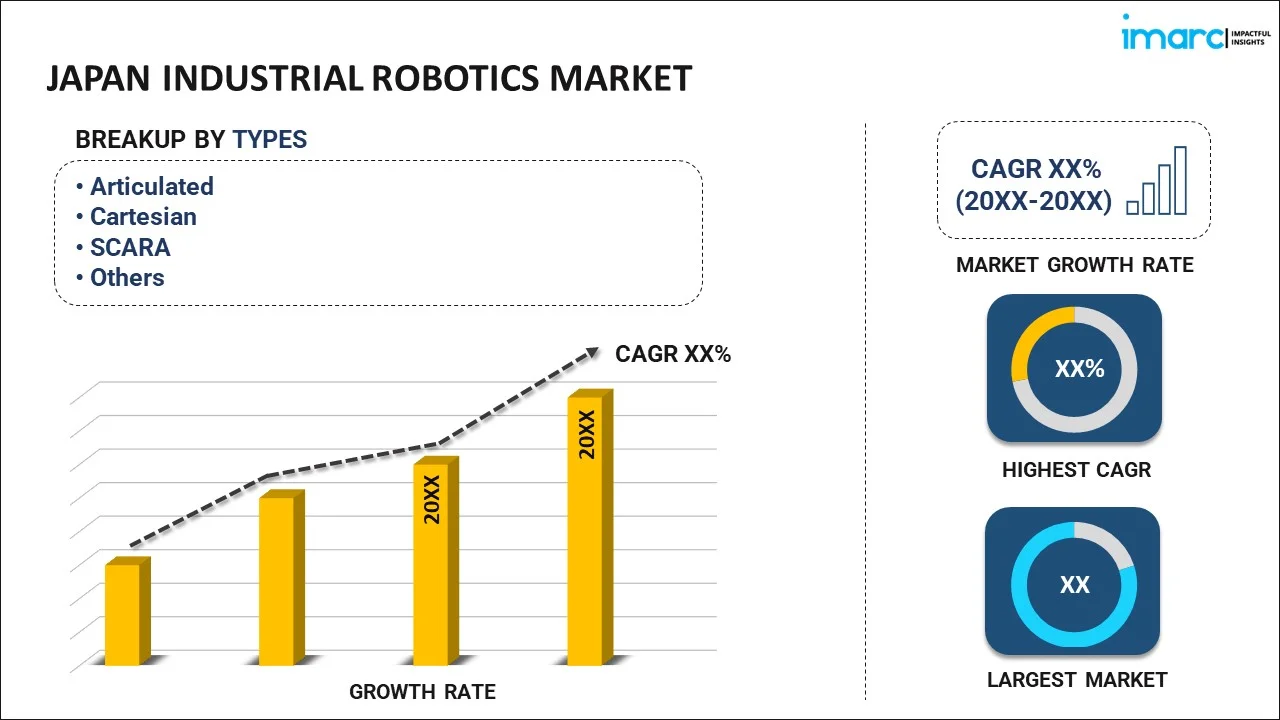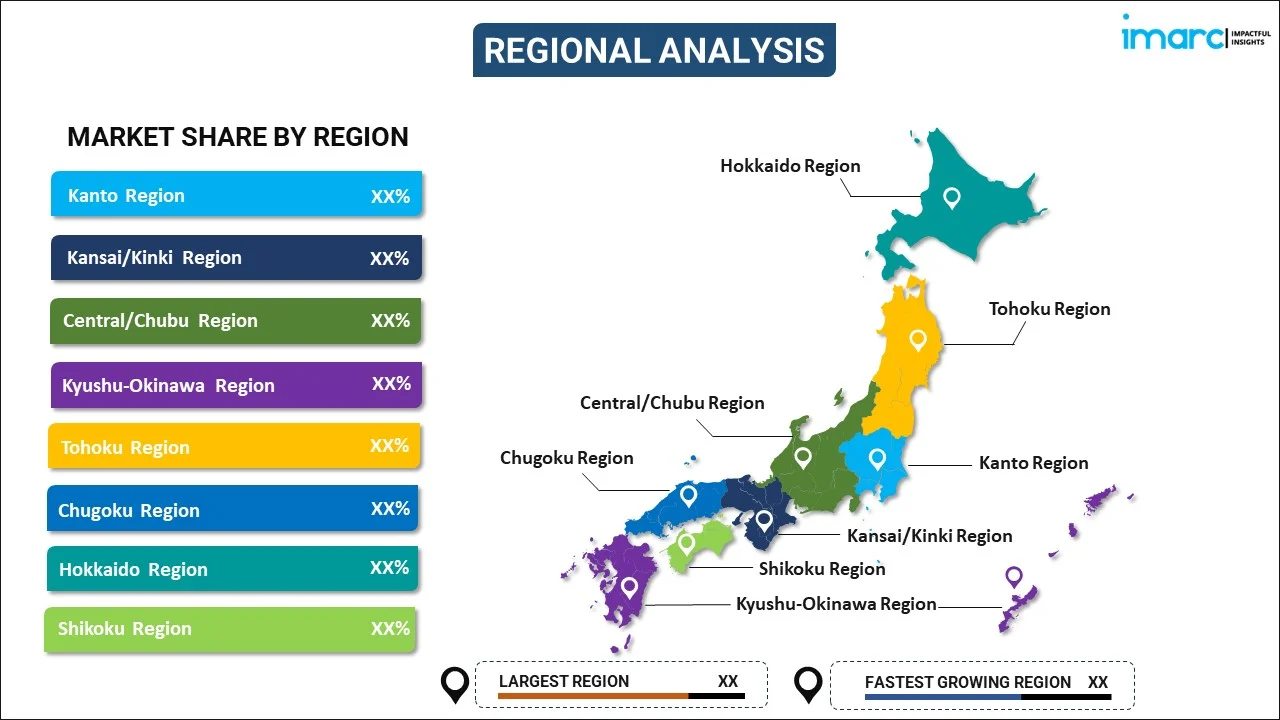
Japan Industrial Robotics Market Report by Type (Articulated, Cartesian, SCARA, Cylindrical, and Others), Function (Soldering and Welding, Materials Handling, Assembling and Disassembling, Painting and Dispensing, Milling, Cutting, and Processing, and Others), End User (Automotive, Electrical and Electronics, Chemical Rubber and Plastics, Manufacturing, Food and Beverages, and Others), and Region 2025-2033
Market Overview:
Japan industrial robotics market size reached USD 1,171 Million in 2024. Looking forward, IMARC Group expects the market to reach USD 2,710 Million by 2033, exhibiting a growth rate (CAGR) of 9.8% during 2025-2033. The inflating need for maintaining high product quality and production efficiency, along with the workforce shortages, is primarily driving the market growth.
|
Report Attribute
|
Key Statistics
|
|---|---|
|
Base Year
|
2024 |
|
Forecast Years
|
2025-2033
|
|
Historical Years
|
2019-2024
|
| Market Size in 2024 | USD 1,171 Million |
| Market Forecast in 2033 | USD 2,710 Million |
| Market Growth Rate (2025-2033) | 9.8% |
Industrial robotics refers to the use of automated, programmable machines designed to perform a variety of tasks within manufacturing and industrial settings. These robots are equipped with sensors, control systems, and mechanical components that enable them to carry out precise and repetitive tasks with a high degree of accuracy and efficiency. Industrial robots are utilized in a wide range of industries, including automotive manufacturing, electronics, pharmaceuticals, and food production. They are capable of tasks such as welding, assembly, painting, material handling, and quality inspection. Industrial robotics offers several advantages, including increased productivity, improved product quality, reduced labor costs, and enhanced workplace safety by handling tasks that may be hazardous for humans. As technology continues to advance, industrial robotics is evolving with the integration of artificial intelligence, machine learning, and sensors to make robots more adaptable and capable of working alongside human operators in collaborative environments, ushering in a new era of automation and efficiency in industrial processes.
Japan Industrial Robotics Market Trends:
The Japan industrial robotics market is a dynamic and influential segment of the country's manufacturing landscape. Renowned for its technological prowess, Japan has been at the forefront of industrial robotics development and deployment. Japanese companies such as Fanuc, Yaskawa Electric, and Kawasaki Heavy Industries have established themselves as global leaders in the production of industrial robots. The market's growth is driven by factors such as the need to enhance manufacturing efficiency, address labor shortages, and maintain product quality. Japanese industries, including automotive, electronics, and precision engineering, heavily rely on industrial robots for tasks such as assembly, welding, and quality control. Moreover, the emergence of collaborative robots (cobots) is opening new avenues for human-robot collaboration, particularly in smaller and medium-sized enterprises. With a strong emphasis on research and innovation, coupled with supportive government policies, the Japan industrial robotics market is expected to continue thriving and shaping the future of manufacturing automation not only within the country.
Japan Industrial Robotics Market Segmentation:
IMARC Group provides an analysis of the key trends in each segment of the market, along with forecasts at the country level for 2025-2033. Our report has categorized the market based on type, function, and end user.
Type Insights:

- Articulated
- Cartesian
- SCARA
- Cylindrical
- Others
The report has provided a detailed breakup and analysis of the market based on the type. This includes articulated, cartesian, SCARA, cylindrical, and others.
Function Insights:
- Soldering and Welding
- Materials Handling
- Assembling and Disassembling
- Painting and Dispensing
- Milling, Cutting, and Processing
- Others
A detailed breakup and analysis of the market based on the function have also been provided in the report. This includes soldering and welding, materials handling, assembling and disassembling, painting and dispensing, milling, cutting, and processing, and others.
End User Insights:
- Automotive
- Electrical and Electronics
- Chemical Rubber and Plastics
- Manufacturing
- Food and Beverages
- Others
The report has provided a detailed breakup and analysis of the market based on the end user. This includes automotive, electrical and electronics, chemical rubber and plastics, manufacturing, food and beverages, and others.
Regional Insights:

- Kanto Region
- Kansai/Kinki Region
- Central/ Chubu Region
- Kyushu-Okinawa Region
- Tohoku Region
- Chugoku Region
- Hokkaido Region
- Shikoku Region
The report has also provided a comprehensive analysis of all the major regional markets, which include Kanto Region, Kansai/Kinki Region, Central/ Chubu Region, Kyushu-Okinawa Region, Tohoku Region, Chugoku Region, Hokkaido Region, and Shikoku Region.
Competitive Landscape:
The market research report has also provided a comprehensive analysis of the competitive landscape in the market. Competitive analysis such as market structure, key player positioning, top winning strategies, competitive dashboard, and company evaluation quadrant has been covered in the report. Also, detailed profiles of all major companies have been provided. Some of the key players include:
- Fanuc Corporation
- Kawasaki Heavy Industries, Ltd.
- Mitsubishi Electric Corporation
- Nachi-Fujikoshi Corp.
- Seiko Epson Corporation
(Please note that this is only a partial list of the key players, and the complete list is provided in the report.)
Japan Industrial Robotics Market Report Coverage:
| Report Features | Details |
|---|---|
| Base Year of the Analysis | 2024 |
| Historical Period | 2019-2024 |
| Forecast Period | 2025-2033 |
| Units | Million USD |
| Scope of the Report | Exploration of Historical and Forecast Trends, Industry Catalysts and Challenges, Segment-Wise Historical and Predictive Market Assessment:
|
| Types Covered | Articulated, Cartesian, SCARA, Cylindrical, Others |
| Functions Covered | Soldering and Welding, Materials Handling, Assembling and Disassembling, Painting and Dispensing, Milling, Cutting, and Processing, Others |
| End Users Covered | Automotive, Electrical and Electronics, Chemical Rubber and Plastics, Manufacturing, Food and Beverages, Others |
| Regions Covered | Kanto Region, Kansai/Kinki Region, Central/ Chubu Region, Kyushu-Okinawa Region, Tohoku Region, Chugoku Region, Hokkaido Region, Shikoku Region |
| Companies Covered | Fanuc Corporation, Kawasaki Heavy Industries, Ltd., Mitsubishi Electric Corporation, Nachi-Fujikoshi Corp., Seiko Epson Corporation, etc. |
| Customization Scope | 10% Free Customization |
| Post-Sale Analyst Support | 10-12 Weeks |
| Delivery Format | PDF and Excel through Email (We can also provide the editable version of the report in PPT/Word format on special request) |
Key Questions Answered in This Report:
- How has the Japan industrial robotics market performed so far and how will it perform in the coming years?
- What has been the impact of COVID-19 on the Japan industrial robotics market?
- What is the breakup of the Japan industrial robotics market on the basis of type?
- What is the breakup of the Japan industrial robotics market on the basis of function?
- What is the breakup of the Japan industrial robotics market on the basis of end user?
- What are the various stages in the value chain of the Japan industrial robotics market?
- What are the key driving factors and challenges in the Japan industrial robotics?
- What is the structure of the Japan industrial robotics market and who are the key players?
- What is the degree of competition in the Japan industrial robotics market?
Key Benefits for Stakeholders:
- IMARC’s industry report offers a comprehensive quantitative analysis of various market segments, historical and current market trends, market forecasts, and dynamics of the Japan industrial robotics market from 2019-2033.
- The research report provides the latest information on the market drivers, challenges, and opportunities in the Japan industrial robotics market.
- Porter's five forces analysis assist stakeholders in assessing the impact of new entrants, competitive rivalry, supplier power, buyer power, and the threat of substitution. It helps stakeholders to analyze the level of competition within the Japan industrial robotics industry and its attractiveness.
- Competitive landscape allows stakeholders to understand their competitive environment and provides an insight into the current positions of key players in the market.
Need more help?
- Speak to our experienced analysts for insights on the current market scenarios.
- Include additional segments and countries to customize the report as per your requirement.
- Gain an unparalleled competitive advantage in your domain by understanding how to utilize the report and positively impacting your operations and revenue.
- For further assistance, please connect with our analysts.
 Inquire Before Buying
Inquire Before Buying
 Speak to an Analyst
Speak to an Analyst
 Request Brochure
Request Brochure
 Request Customization
Request Customization




.webp)




.webp)












